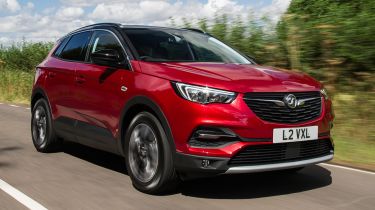New Vauxhall Grandland X Elite Nav diesel review
The Vauxhall Grandland X is now available with PSA's efficient 1.5-litre diesel engine. We find out how it compares to the old 1.6 unit...

This more powerful diesel engine only adds to the appeal of Vauxhall's family SUV. It's smooth, refined and capable of decent real-world economy. But we're less sure that about our car’s Elite Nav trim, which nudges the price close to the £30,000-mark. We've always been more convinced by the lower end of the Grandland X line-up; and our judgement here hasn’t changed.
The Vauxhall Grandland X has been doing quiet business for the British brand for over a year now, giving it a viable family SUV in a period when it seems that almost every family wants to buy one.
The car, which is based on the same underpinnings as the capable and fashionable Peugeot 3008, is now being offered with a more potent diesel engine - and we've had a chance to try it on British roads.
The 1.5-litre unit replaces the old 1.6 motor, as part of the PSA Peugeot-Citroen Group's rollout of more efficient engines across its range. The new arrival produces 128bhp (a gain of around 10bhp) but it emits as little as 108g/km of CO2 if you choose it in one of the Grandland X's more modest trim levels with smaller wheels.
Used - available now

2021 Land Rover
Range Rover
27,750 milesAutomaticDiesel3.0L
Cash £49,995
2022 BMW
3 Series Touring
52,456 milesAutomaticDiesel2.0L
Cash £23,800
2018 Mazda
6 Saloon
48,985 milesAutomaticPetrol2.0L
Cash £12,600
2023 Mercedes
EQC
55,207 milesAutomaticElectric
Cash £22,300Here, though, we're testing the engine in Elite Nav spec, which brings 19-inch diamond-cut alloy wheels that nudge the CO2 emissions up to 110g/km. It's a generously equipped model overall, in fact, because it also gets a panoramic glass sunroof, an eight-inch colour touchscreen with navigation, Android Auto and Apple CarPlay, a wireless smartphone charger, cruise control, part-leather upholstery, and front and rear parking sensors.
The good news is that the engine does feel like a fair improvement over the old 1.6. It's happy to pull the Grandland X along at a brisk pace, with enough torque to ensure that you don't really need to reach the revs where any diesel clatter would be an issue. In fact, at motorway speeds the engine fades away nicely – allowing the tyre roar from those big rims to come to the fore.
That extra tractability is welcome, in fact, because as is almost always the case with PSA models, the manual gearbox isn't that satisfying to use. There's a precise enough mechanism in there somewhere, but it's well hidden behind a baggy linkage that leaves you feeling uninvolved.
The rest of the Grandland X package is unchanged, of course. There's plenty of grip but considerable body roll if you really try to throw the car down a twisty road, so it's best to back off a little and enjoy the comfort instead. The car copes well with all but the sharpest road imperfections and this really does feel like one of the major dividing lines between the Vauxhall and, say, the SEAT Ateca, which is more rewarding if you want some fun behind the wheel.
The cabin, meanwhile, offers decent space for four adults – and three could sit in the back for a shorter journey without much complaint. There's plenty of head and legroom, and at 514 litres, the big, wide boot should be enough for most families' needs. Interior quality is solid rather than exceptional, with plenty of soft-touch materials but the odd bit of flimsy plastic lower down.
The biggest problem with the car we tested was price. Elite Nav spec costs £28,780, which pitches the Grandland X against some premium opposition. The more efficient SE trim costs around £4,000 less and will be the better option for most.












